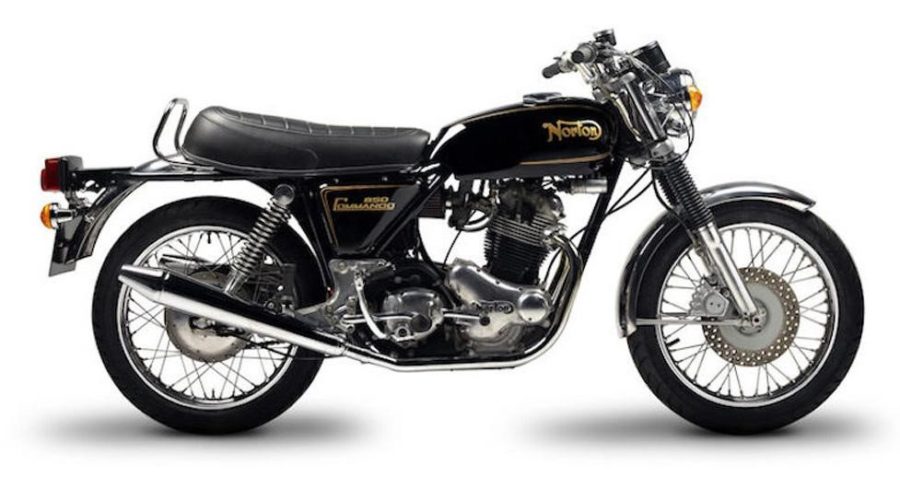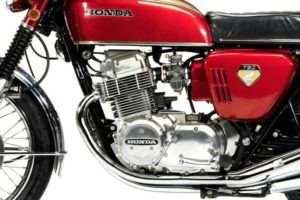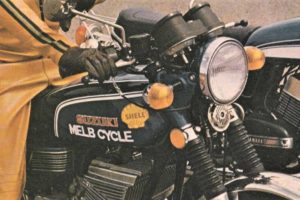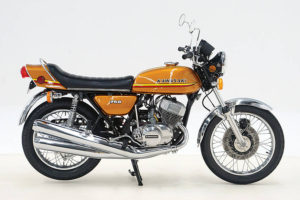1973 Norton 850 Commando
Conqueror of distance and time, this twin has the stamina to survive until the wheel turns full circle, returning simplicity to motorcycle powerplants. And, if that hasn’t already happened, the 850 might be the bike that makes you realise it should.
Dawn. The rose-pale lightening of the Eastern sky spreads an aura of softness, blurring otherwise harsh outlines, imparting a wraith-like quality to familiar objects and scenes. The chrome and red shadow flitting along the deserted ribbon of asphalt blends with the hour’s misty unsubstantiality; only sleepy roosters and homecoming tomcats note its passage, its sound the deep mutter of far-off summer thunder, felt rather than heard.
Aboard the Andover Express, you ‘re the archetypal lone rider, but there’s company on the road: shapes even less solid than yourself, ghostly entities glimpsed from the corner of an eye, black-leathered riders in pudding-basin helmets aboard silver-grey machines.
The everchanging surface below your wheels is read and analysed, felt and compensated with the exact grace of classical ballet. Seldom can you ride this well and you realise that most of the credit must go to the machine. And like the ghosts who have been sharing the day’s first misty moments with you, your bike has a distinctive emblem, a single word in decorative script emblazoned on the tank: Norton.

Norton. Ride one, and you ride a legend; your pre-dawn company will be the great names of the past. Ride the Commando 850, and you ride a legend updated, an amalgam of 40 years of mechanical evolution, an anachronistic throwback to an age long dead, a hymn to the prowess of modern technology, sometimes heartbreaking, often frustrating, always extraordinarily capable and exhilarating.
Back in the numbing grind of a large city’s traffic and the stress of daily life, viewpoints tend to shift. The memory of magic rides fades (for such come rarely, no matter what the bike you ride) and it’s with a critical frown you note the tell-tale puddle of oil on the garage floor, listen to the whirrs and rattles from the power unit, wrestle the machine through tight spaces, and curse the vibration which spoils a huge power spread.
In that it possesses a strong character, the 850 is typically Norton; relationships with it are a mad love/hate mixture. One thing it can’t be accused of is adequacy, the science of not making mistakes.
It’s traditionally and uncompromisingly Norton all right, but it’s also something more. The extra displacement has given it that much more authority to stake its claim to a place in the Superbike ranks. Its predecessor, the 750, won its place fair and square; big brother improved even more on the threequarter litre’s strong points. Norton Villiers has correctly judged how to make the Commando package better without destroying the basic concept.
For those who equate extra size with more power the revelation that the 850 produces the same as the 750 will doubtless be a disappointing one. It shouldn’t be, in the light of what has been gained in the trade-off of specific output. Compression ratio down, power band lowered and lengthened, the capability of running on low octane or no lead fuel, improved emission control measures, less mechanical strain – they’re all sweet words in an era when legislation is looming that will kill the hot performers as we know them.
Norton’s refining process has put one of motorcycling’s most ancient power units to the forefront in the current swing to simplicity and economy. Just proves that if you stick around long enough the wheel will turn full circle …

Typically, Norton-Villiers’ approach has been a host of detail improvements rather than a fell swoop of the designer’s pen. Even the capacity increase is the result of no more than a bore increase of 4 mm, from 73 to 77 mm. Actual capacity is now 828 cc. At the same time the high-performance camshaft sported by the Combat model has been replaced with the milder “S” pattern, bringing peak power (60 hp claimed) back from 6500 to 5800 rpm. A mild 8.5:1 compression ratio rounds out the basic motor package.
Where most of the detail changes have been aimed is in beefing the motor up, a wise move overall. Commando riders like moving swiftly, and many tend to forget that there’s a limit to the revving an undersquare pushrod twin with only two main bearings can take. Consider also that the Commando motor has a beautifully designed head which allows past the redline spinning and the embarrassing reputation for the motor’s unreliability becomes fairly understandable.
Improved crankshaft material and new main bearings should work with the lower power band to improve the situation. The bearings incorporate rounded ends on the rollers to alleviate the extremely narrow contact path of conventional rollers when the shaft starts flexing at high revs.
Two of the obvious exterior changes are the replacement of the previous flange-belting of the barrel with through belts from the top (located much closer to the cylinder bore), and the Dunstalltype coupler tube between the two exhaust pipes. Revised crankcase breathing now has the take-off pipe coming from the timing case and depositing fumes to the top of the oil tank, from where another pipe takes the residue vapor to the air cleaner.
The lubrication system is a masterpiece of oily complexity; as well as the breather pipes mentioned, there’s the external feed lines to the head, and the major supply lines, the return branch passing through a filter located below the swingarm pivot. Chain oiling is taken care of in enthusiastic fashion by a smaller tube from the return line.

With so many external connections, leaks are inevitable, and our test bike had its share. The pity is that the problem could be cured: more positive clamping at the ends of the armored rubber hoses would cut out 99 percent of the problem, while some method of restricting and graduating flow to the chain is a necessity.
Norton Villiers have coped successfully with leaks from the motor itself (the test machine showed a tiny smear round the front barrel bolt and not a drop anywhere else, top or bottom).
Tidying the machine is one of life’s simpler tasks. Apart from the nook between motor and gearbox the 850 has few awkward little corners and the liberal use of chrome, polished alloy and stainless steel adds up to a surprisingly easy-to-clean-unit considering its non-unit construction.
In Roadster form, with the 11 litre (2.5 gallon) tank, the 19- inch wheels and upswept pipes lend a rangy, spidery air to the bike. Not so with the Interstate, no sir. Dominated by the monstrous 27 litre (5.75 gallon) fuel container, the rest of the machine shrinks in proportions, ending up with a nicely balanced design. At first sight the kink halfway along the Interstate’s exhausts seems a trifle fussy but it doesn’t take long to appreciate the symmetry of the system.
The NV stylists have achieved the near impossible with the Interstate’s huge tank by imparting traditional sporting lines to it. The whole bike in fact, betrays its ancestry; everything is neat yet rugged. Castings especially display an air of unbreakable simplicity, in particular the brake caliper, rocker box and intake stubs.
Cradling the big motor is Norton’s answer to the parallel twin shakes, the Isolastic frame. It’s most eye-catching feature – a top tube the size of a city water main – is normally hidden and it’s quite a revelation to remove the seat and get a look at it. Running from the top of the steering head, it ends against a flat steel plate between the sub-frame top rails at the shock absorber mounts, with the diagonal sub-frame brace sprouting from it further forward at the rear of the tank. Twisting it would be about as easy as kicking the Sydney Harbor Bridge to bits with gym boots, and therein lies part of the reason why Commandos handle so well.
The big rubber bushes on which the engine/gearbox/swing arm complex is mounted are located at the front and top of the motor and the top of the gearbox. Because a chain primary drive is employed the gearbox is not a load-carrying part of the system, that job going to thick steel plates between motor and swing arm pivot, and slotted to allow gearbox movement during chain adjustment.

We’ve always considered the Isolastic idea to be a cheating way round a tough problem, and separate engines and gearboxes belong in museums along with sabre-tooth tiger carcases but there’s no denying the whole thing works – while it’s new at least.
With the alternative being a brand new motor, something which probably would have pulled the financial plug on Norton Villiers, we should be thankful for the brilliant improvisation they’ve displayed. At least the motorcycling world still has a famous name as going concerns.
The first few moments of acquaintance with the 850 are apt to give a poor impression; despite it being one of the lightest of the big brigade at 196 kg (430 lb), it detracts from this with giant-sized dimensions and a restricted steering lock. If the bike’s out in the open, pointed the way you intended to go, you’ll not notice. But you will if you have to heave it out of a restricted space. The bars are wide, the seat is 32 inches (83 cm) clear of the deck and unless you have an inside leg measurement of at least that, you’ll never be able to swing the side stand out. It angles so far forward the average leg runs out of length long before the stand is past the pivot point. It’s a good stand though – its long gentle curve presents a phenomenal bearing length to the ground and even on muddy grass there’s no way the machine will tip over. And that makes it even more annoying that it can’t be operated.
Things become much brighter when the time comes for the bike to do a bit of the work itself. Despite a certain amount of effort called for from the kickstart (when you’re squeezing 412 cc per pot you’ve gotta expect some resistance!), the bike starts first or second swing every time, hot or cold. The carbs need a tickle to flood the float bowls and cold starts called for half choke from the handlebar lever, but apart from that there’s no drama at all. Amal Concentrics are reputed to be prone to flooding if tickled too vigorously, but we found none of this with the test machine. At anything from a suspicion of dampness through to a stream of fuel from the flat we had impeccable starting behaviour.

Once operating the carbs became somewhat slack about the whole deal, refusing to hold slow consistent idle for any length of time. We ended up settling for a 1200 rpm idle, faster than we’d have liked, but at least steady. At this engine speed the Isolastic system isn’t really happy about its appointed task, and shivers and shakes away in fine fashion. The peak of such behaviour is reached just past 2000 rpm when one gets the impression of a thousand coil springs spronging away inside. Sadly, it persists right up to 3000 rpm, a speed at which the motor delivers tremendous torque, but rendered uncomfortable by the shaking going on.
This forces more gear changes than one desires, and detracts from one of the bike’s strongest points – its incredible spread of power. Experienced Commando riders tell us that fine adjustment of the Isolastic side-play (a critical figure in any event) will bring the upper limit of the shakes down to 2500 rpm and make the bike a lot more comfortable for round-town work.
In the upper ranges the motor is far smoother, the 3000-4500 rpm band being particularly good. With the long gearing, this represents about 50 to 80 mph (80-130 km/h) in top. The bike delivers the most relaxed 70 mph we’ve ever encountered. Even the top end shakes are far from annoying; they’re there, but very little comes through the tank and none through the fat cushion handgrips. The amount coming through the footpegs keeps the feet awake rather than putting them to sleep.

The open road is the Norton’s territory, yet it doesn’t disgrace itself around town either. The main drawbacks are those associated with any big bike: size, awkwardness at ultra-low speeds, and the sense of frustration at not being able to take advantage of the machine’s potential.
Ah, but the open road! That’s where it all comes together, where the deep boom of the Norton’s pipes is a gentlemanly challenge to all others. There are many pretenders to the throne; few are as worthy of it as the 850. Not the dead straight superhighways only; the Norton is relaxed at high speeds on this sort of road to the point of being boring, because its true potential is not being exploited. Where the bike really shines is the minor routes, full of bends and changing surfaces.
After a hard run through a known course of this type of territory, one’s initial reaction can be disappointment at the lack of drama. It’s only when you check the time taken you realise just how swiftly the distance has been put behind.
Through anything from a hairpin up to a flat-out sweeper no effort is called for by the steering. The bike simply settles smoothly to the desired angle of lean and follows the chosen path. Belting through a series of left-right-lefts is even more fun. Again the 850 unerringly follows the line you’ve chosen in your mind, swinging from lock to lock with no more than a gentle movement of the hips. The whole effect is one of tremendous competence – the 850 seems to get more out of you in terms of skill than other bikes.
Despite the steering’s lightness, it doesn’t have the expected tendency to wander. Kicking the rake out another degree from the 750 has made the bike quite steady in a straight line. Not perfect, for gusty side-winds can prompt more movement than desirable, a probably unavoidable compromise.

The bike’s suspension is up to the same high standards as the steering. Springing both ends tended to be on the stiff side of perfect, able to beat the damping when heavier bumps are encountered. At no times however did we get the impression of the plot going all out of hand, despite purposely trying on a vicious ripple we know of halfway through a 90mph sweeper. The steering gave a quick shake, transmitted to the rear in an easy corkscrew motion, but the bike continued happily on its way, still on line, the footpeg still kissing the asphalt.
Truly desperate cornering is inhibited by ground clearance, particularly on the left. The centre and side stands and footpeg all start grinding away, followed marginally afterwards by the exhaust pipe. On the other side it’s confined to peg and pipe. Yet the bike doesn’t rate a brickbat for ground clearance, simply because at the speeds you’re going you’d be running rings around all but a select handful of the world’s best motorcycles.
Despite the bike’s marvellous back-road manners, travelling on the dirt has to be a big no-no. The Dunlop TT100s are very unhappy on a gravel surface and combine with the quick steering, massive torque and high centre of gravity to produce huge hairy slides at the slightest excuse.
Another of the bike’s relaxing habits is the way the brakes work. Both ends are progressive in effect, producing the retardation needed and no more. Under panic stop conditions the picture is less rosy, with the back drum unable to match the big Norton/Lockheed disc for power, and fading away when pounded hard. Despite being so progressive, the disc calls for a heavier than expected hand pressure under all conditions. While super-sensitive units are a dangerous nuisance, this one erred too much the other way.
For any bike to rank as a top-line tourer it must above all else be comfortable and have a decent range. This is where the Norton design team have obviously aimed the 850.
The seat looks too wide to be comfortable, but turned out beautifully so, while the massive tank coupled with the 40 mpg consumption makes stops very infrequent. Despite the seat being finished in a weave material (which should stop the rear end getting all hot and sticky in summer) it lacks the kick halfway along of last year’s 750, and the unwary rider can tend to slide back under exuberant acceleration.
That’s a property of which the bike has a more than adequate amount. We laid a fuss-free series of 13.5-13.8 second quarter mile runs, losing a fraction out of the hole each time as the tall gearing bogged the bike clown. And just as impressive as the 115 mph (185.1 km/h) top speed is the bike’s capacity to run for hours at 90-plus, the only inhibition being a too-upright seating position. The wide bars, a Commando trademark, were the culprits here; if we owned one we’d have shorter ones on in a flash.

Despite a longer than average travel at the lever the gearchange ranks with the very best.
First gear engagement is accompanied by a gentle click, no more, neutral can be selected at any time (when you need it that is) and the box is happy with clutchless shifts both up and down. The all-steel diaphragm spring clutch has had an extra plate added (bringing the total to five) and performed tirelessly during the test.
Lever pressure is high but not excessive, but the unit had the distressing habit of taking up with startling suddenness when the revs were low. Until we got into the habit of having at least 3000 rpm up when moving off (the motor’s so strong it could move off from 1500 rpm), we had more than a fair share of stalls. Annoying and embarrassing. At higher engine speeds engagement is far more progressive.
Ancillaries on the 850 are all good with the exception of the switches (still too confusing, if easier to use than previously) and the horn ( exceptionally good – the propensity shown by Australian drivers to overtake on the open road without first checking behind can be nipped neatly in the bud with a series of blasts from the Norton’s windtone hooter).
But Norton could well look seriously at redesigning the entire switch layout. The headlight, for example, is controlled by the ignition key on the left hand side panel (light master switch), the toggle switch on the lamp shell (parkers or headlight) and the high/dip switch on the handlebar. Failsafe systems of this type should be confined to bank vaults and nuclear bombers only.
Looked at from the narrow viewpoint of family genetics the 850 Commando is a logical and worthy successor to the 750. While retaining all its virtues it offers greater ruggedness and a more relaxed version of the same power. How it stacks up against the broader spectrum is tougher to define. Looked at logically it offers performance with the best of them, handling that few can equal, enormous cruising range and a quite attractive price tag.
But there’s something more again, something that keeps a rider loyal while still admitting, yes, I spend half the time chasing oil leaks, and yes, the bloody primary chain needs adjusting again. Press him, and he’ll be lost for words to explain.
Only if you’ve ridden one yourself will you recognise the faraway look in his eyes and realise that once in a while, on some magic stretch of road , he becomes touched with greatness, and rides in very special company.
By Derek Pickard, Two Wheels, December 1973

Guido from AllMoto owns a delicious MkIII Commando. Read about the good, bad and ugly of the experience here.




